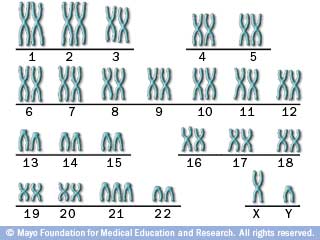This genetic disorder, which varies in severity from a baby to another, causes a lifelong intellectual disability, developmental delays and difficulties in education among children with Down syndrome.
Early intervention can greatly increase the quality of life for children and adults with Down syndrome and help them coexist with the community.


Symptoms:
Intellectual difficulties among people with Down syndrome range from mild to moderate.
Children with Down syndrome have similar facial features, including:
- Small head
- Short neck
- Flat back of head
- Large and protruding tongue
- Upward slant to the eyes
- Small ears
- Short hands
- Palm contains only one or two lines
- Relatively short fingers
- Small white spots on the colored part (iris) of the eye called Brushfield spots
- Short stature
Types & Causes:
Is it inherited?
Scientific studies have proved that the Down syndrome is not inherited, and the main cause is an error in cell division of the egg or sperm or during formation of embryos.
Translocation Down syndrome is the only form which can be transmitted from a parent to a child, affecting about 4% of children with Down syndrome:
- If father is the carrier, the risk is about 3 percent.
- If mother is the carrier, the risk is between 10 and 15 percent.
Risk factors:
Some parents have a higher risk of having a baby with Down syndrome. This includes:
- Advancing mother age: As the mother gets older, the probability of having a child with Down syndrome increases because older eggs have a greater risk of improper chromosome division.
The risks of Down syndrome depend on the age of the mother:
- At age of 35, the risk of having a child with Down syndrome is 1 in 350.
- At age of 40, the risk of having a child with Down syndrome is 1 in 100.
- At age of 45, the risk of having a child with Down syndrome is 1 in 30.
- After having a child with Down syndrome: A woman who has a child with Down syndrome is more likely to have another child with the same condition by 1 in 100.
- Mother and father who carry the gene of Down syndrome resulted from translocation can pass the disorder to their child.
Complications:
Children with Down syndrome can have many complications; some of them become more prominent as they get older, such as:
- Heart defects: About half of children with Down syndrome are born with different types of heart defects. Some of them may be life-threatening and may require surgery in early infancy.
- Leukemia: Children with Down syndrome have an increased risk of leukemia.
- Infectious diseases: Because of abnormalities in their immune systems, those with Down syndrome are much more at risk of infectious diseases, such as pneumonia.
- Dementia: Those infected with Down syndrome have a greatly increased risk of dementia and symptoms and signs may begin around age 50. This also increases the risks of convulsions and Alzheimer's disease.
- Sleep apnea: Due to changes in tissues and bones, the airway is obstructed. Children and adults with Down syndrome are more susceptible to the risk of sleep apnea.
- Obesity: People with Down syndrome have a greater tendency to be obese compared with those in the same age.
- Other health problems: Down syndrome is associated with other health problems, including intestinal obstruction, thyroid problems, early menopause, convulsions, ear infections, hearing loss, poor eyesight, and skin problems such as psoriasis.
Life expectancy:
In 1910, children with Down syndrome often did not live to age 10.
But today, they may live up to age of 60 and beyond, depending on the severity of their health problems.
Diagnosis:
- Tests during Pregnancy:
- Screening test: To detect the likelihood a mother is carrying a baby with Down syndrome.
- Diagnosis test: To identify whether your baby has Down syndrome.
First trimester screening:
- Blood test: This blood test measures the levels of pregnancy-associated plasma protein-A (PAPP-A) and the pregnancy hormone (HCG). Abnormal levels of these proteins may indicate a problem with the baby.
- Ultrasound: It is used to measure a specific area on the back of your baby, to detect any abnormalities.
Based on the results of blood test and ultrasound, in addition to the mother's age, the doctor can estimate the risk of having a baby with Down syndrome.
This test is considered more specific than other screening methods for Down syndrome.
Treatment:
- Early intervention programs: Programs vary, but they usually involve therapists and special educators for this category, designed to help the baby develop motor skills, language, social skills and self-help skills.
- Team care: There should be a medical team care for the child with Down syndrome. The team may include some of these experts:
- Primary care pediatrician.
- Pediatric gastroenterologist.
- Pediatric endocrinologist.
- Pediatric neurologist.
- Pediatric ear, nose and throat (ENT) specialist.
- Pediatric eye doctor (ophthalmologist).
- Audiologist.
- Physical therapist.
- Specialist, special education for Down syndrome category.
Prevention:
There is no way to prevent giving birth to a baby with Down syndrome. If the parents or one of them carrying the translocation type of Down syndrome, or the family already have one child with Down syndrome, you must consult a genetic counselor before becoming pregnant.
Related links: